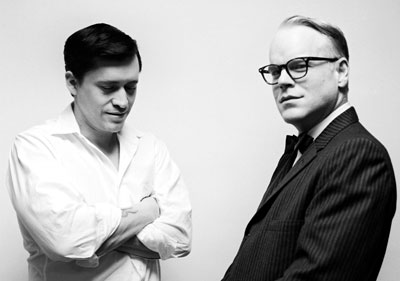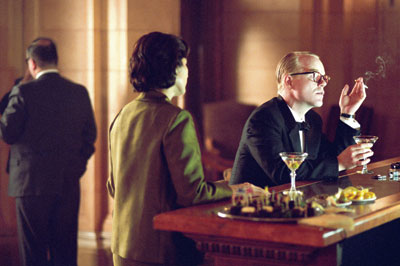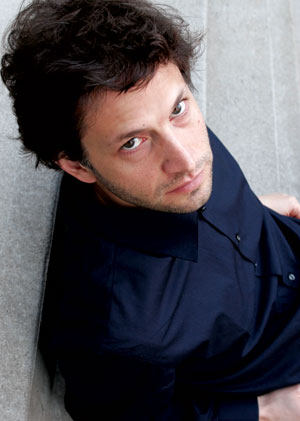CASUALTIES OF FAME
With a deeply layered performance by Philip Seymour Hoffman, Bennett Miller’s Capote explores the great cost of artistic creation.
BY PETER BOWEN
Capote director Bennett Miller.
PHOTO: HENNY GARFUNKEL/RETNA LTD.
Bennett Miller’s dramatic profile Capote provides a fascinating counterpoint to the filmmaker’s 1998 documentary The Cruise. Both films showcase quirky, creative lead characters: The Cruise’s motormouth poet of the tour bus, Speed Levitch, and Capote’s eponymous protagonist, the helium-voiced pixie of the New York literary world. But beyond — or perhaps because of — their stranger-than-fiction real-life characters, both films raise complex ethical questions about the documentary form itself. In The Cruise the problem of “who was using whom?” was implicit in the production. Was Miller taking advantage of Speed’s oddball brilliance or was the documentary just another stage for Speed to rant and rave on? Now the questions of exploitation and truth that were implicit in The Cruise become the dramatic center of Capote.
Rather than tell Truman Capote’s life story, screenwriter Dan Futterman (working from Gerald Clarke’s biography) focuses on a single section of his life — the chain of events leading up to the publication of In Cold Blood. On Nov. 15, 1959, Capote (Philip Seymour Hoffman) reads in the New York Times about the murder of the Clutter family in Holcomb, Kan. Captivated by the story’s inherent drama — the violent murder of an upstanding family in America’s heartland — Capote convinces New Yorker editor William Shawn (Bob Balaban) to pay for him and his childhood friend Nelle Harper Lee (Catherine Keener) to travel to Kansas to cover the aftermath of the crime. Fascinated by the good Kansas folk — as his Bergdorf scarves and fluttering hands are captivating to them — Capote ultimately becomes consumed by the story when he meets Perry Smith (Clifton Collins Jr.), one of the two accused killers.
In Cold Blood would become Capote’s greatest achievement and the beginning of his end. The inherent truth of the book made all of America pay attention to the power of reportage. Controlling that truth, however, proved to be an emotional and ethical mire for Capote, one that the writer never seemed to escape. For halfway through the story, Capote not only falls in love with Perry Smith, his subject, but also needs him to die for the story to end.
Like the man, Capote is impeccably dressed. Jess Gonchor’s production design, Kasia Walicka-Maimone’s costumes, Adam Kimmel’s cinematography and Mychael Danna’s score together conjure for the viewer the “creative interiority” that Capote retreated to, created from and ultimately got lost within.
 |
| Clifton Collins Jr. and Philip Seymour Hoffman in Bennett Miller’s Capote. |
FILMMAKER: Having made a documentary yourself, you must have related to Capote’s predicament, that at some point the facts of the documentary and the structure of the story come into conflict?
MILLER: Like Capote, my attempt was to remain as truthful as possible, but again like Capote, there is not a set truth that I am after. For me, there is a story about Truman Capote, which is about a journalist doing what he needs to do to get his masterpiece done. There is also something more than that: the truth of human nature that it is trying to exist, whether or not Truman Capote goes to Kansas, or even whether Truman Capote existed or not.
FILMMAKER: This comes out I guess in how the filmmaker or writer deals with his subject?
MILLER: There is a parallel between the writer and his subject and the documentary filmmaker and his subject. Capote had his own personal interests, and he used his subject as a kind of vehicle to get at them. When I made The Cruise it was quite similar. I had my own personal reasons and hopes for this film. Of course, I committed myself to a form and a subject, and whether my interests were in sync with the truth of that subject is the question.
FILMMAKER: So Speed was your Perry Smith?
MILLER: Yes, in a way.
FILMMAKER: Did you have a specific interest in Capote before this film?
MILLER: I loved that book In Cold Blood and the Maysles Brothers’ documentary [A Visit With Truman Capote] was fascinating, but I had never made any special investigation into Capote or his work.
FILMMAKER: Then how did you come to make a film about Truman Capote?
|
FILMMAKER: What did you like in his screenplay?
MILLER: Dan thought it was a great story about a journalist. And that was true, but something else interested me more — how the story was a classic tragedy. Capote has something in common with Speed here, in terms of his natural charisma and creativity, as well as his adventurousness — all which belies, I think, a more desperate truth.
FILMMAKER: What truth is that?
MILLER: Whether it was happening on the conscious or unconscious level, I think that Capote very methodically dismantled his life. All his life he labored to create an opinion of himself within society. He was adored, respected, revered and praised, and then he really set about altering that collective opinion to be more true to his own opinion of himself, which was in no way nearly as kind.
FILMMAKER: You based the film on Gerald Clarke’s biography. What else did you use?
MILLER: Clarke had in his possession the letters that Perry Smith wrote to Truman Capote, which nobody had ever read except Clarke and his secretary. Clarke also gave us the cassettes of all his interviews with Capote. Those were especially helpful to Phil in order to hear what Capote’s voice sounded like when he wasn’t on some talk show. In public or when he got nervous, Capote’s voice would go up higher than normal. He was a performer, and his cadence changed for the occasion. But in these recordings he forgot he was being taped, and he talked conversationally.
FILMMAKER: When did you learn about the other Capote project, Douglas McGrath’s Every Word Is True, that Killer Films is producing? [Retitled Have You Heard?, the film will be released by Warner Independent next year.]
MILLER: When Danny finished the script, I told him that I would put out some feelers to producers to see who’d be interested. On the very first call that I made I found out that there was a competing project. Up to this point, I had not officially attached myself, and it wasn’t clear whether I should. But then Danny called me and said, “Let’s try to do this thing. You have been reading scripts for years and you have not found anything you like. You love this, so we should try to do it.” He urged and coaxed me in an almost aggressive way, and I am very grateful that he did. There are a million reasons not to make a movie, and sometimes you need to be shaken up a bit to find the reason to [make one]. Our first matter of business was to attach an actor, and there was only one person on the list, and that was Phil. In my mind, Phil was either going to agree to do it or we are not going to make the movie. Within two weeks of him reading it, he signed up.
FILMMAKER: Was this difficult to finance? After all, you were competing with another project for a period piece based on a figure many people don’t know anymore.
MILLER: And that spells box office gold! When Phil and I were pitching the movie, I got to saying that the story has an X factor that is something more than the sum of the circumstances. And I think that’s true.
FILMMAKER: It’s certainly true in the film’s aesthetic. You create a very special vocabulary of using wide shots for emotional effect.
 |
| Catherine Keener and Philip Seymour Hoffman in Capote. |
MILLER: We stacked the head of the film with a bunch of the large landscape shots. When we hold a shot past when you would expect a cut, it makes you go deeper into that moment. This film really strains to create a consciousness that does not tell the story as much as observe it. And these landscapes — very specifically in terms of the colors and the composition, and how they are held — they charge the atmosphere with a kind of consciousness and therefore a context with which to experience this story. [These shots] create a stillness, a soberness, as if nature is at work.
FILMMAKER: What would be an example of that?
MILLER: When the girl, Laura Kinney, walks into her best friend’s room and sees her brains splattered against the wall, she gasps and there is a cut to the girl’s portrait on the mantle. We hold on that and the music begins, and we cut to a landscape shot that we hold for 17 seconds or so. The look is very different from the wheat fields you saw earlier. Here there is tilled land after the harvest, rows of dirt and then barren trees that speak volumes. That landscape says, “death and mortality.” Out of context it doesn’t say anything really, but placed there with that music, it says “death.”
FILMMAKER: What were your visual references for these images?
MILLER: Photographs. I did not choose a specific photographer. Instead I went to Rizzoli [bookstore], and I literally looked at every photograph in every book in their photography section. Literally every single one. If there was one photograph in the book that was relevant, I would buy the book. I spent a few thousand dollars, and I ended up with about 40 or 50 books that were useful.
FILMMAKER: What about film references?
MILLER: I looked at a lot of films too but ended up being more influenced by photographs. The movies that were important to me were not obvious. You’re going to laugh, but I thought about 2001. Obviously it’s not the images but the idea of a movie having consciousness. There is a mesmerizing quality to Kubrick’s work. Also I looked at Wim Wenders’s early movies like Kings of the Road and Alice in the Cities — they had a kind, patient observation to them that also felt like consciousness. And then the Maysles Brothers, films like Salesman, and [Frederick Wiseman’s] Titicut Follies.
FILMMAKER: What about the 1967 film adaptation of In Cold Blood?
|
FILMMAKER: The idea of consciousness seems like a particularly relevant point here, since your film is less about the particular historical event of Capote writing this book than it is about the complicated process by which observation is turned into expression.
MILLER: That’s exactly it. When observation turns into expression. I see myself less as a storyteller and more of a voyeur. This is a movie that observes. It is not telling, it is not didactic, it is not concluding, not pontificating. It is just observing.
FILMMAKER: What makes Capote so complex here is what exactly he observed. I kept watching him and wondering what sentence was forming in his head. But even more, there is that question of what he saw in others. Perry Smith was his subject, but he also seemed like so much more — a friend, a sex object, a literary character, an alter ego.
MILLER: Capote’s feelings for Perry Smith are really fundamental to the movie. I think that Capote and Smith looked at each other and understood something about each other that nobody else understood. At the core, they were very similar. Both of these guys had horrible childhoods — neglect, alcoholism, abandonment, suicide in the family — and they both emerged with a complex that made them turn to art. Perry was just much less successful than Capote, but I think that Capote looked at Perry and saw the same sort of loneliness in him that he felt in himself. When Capote was asked a year after the book was published, What was it about Perry Smith that explained their intense relationship? Capote said, “Perry’s immense loneliness.” Capote was disarmed and became enamored of Perry because of that.
VOD CALENDAR


 See the VOD Calendar →
See the VOD Calendar →



